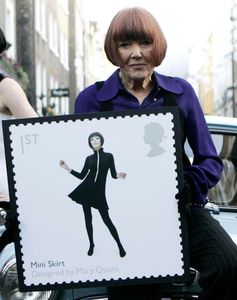Mary Quant, the British fashion designer who died last week at 93, has often been likened to The Beatles. Mostly because when she visited the US in 1966, she was greeted by a sea of fans much like the world’s most famous boy band. A fashion designer receiving such rapturous attention was unheard of. But then, such was the power of the mini skirt, which Quant has been credited with popularising.
The jury is still out on who invented the mini skirt. French designer Andre Courrèges lays claim to it. But this is yet another cultural superiority battle between the French and the English, for which we will not get clear answers. British Vogue claims the inventor of the mini was John Bates, and neither Quant nor Courrèges. American fashion historian Valerie Steele says Quant has more evidence to support her claim.
One would think it does not matter who invented the mini skirt, what matters is that it has outlasted every single trend since the 1960s. Except it does matter. More so that a female designer did not get due credit for something so innovative that it was even beyond fashion. I mean, if this was not a grey area, Quant would have enjoyed the legacy that Coco Chanel did just before her. It did not help that Chanel loathed Quant (“hated me”, in Quant’s own words), perhaps for reasons more to do with professional rivalry than personal.
Quant’s popularity rose in post-war Britain, especially after she opened a little fashion boutique called Bazaar. She became a great influencer. This was the time of women’s sexual liberation, the invention of the birth control pill and the release of feminist author Betty Friedan’s seminal book, The Feminine Mystique. Quant stood for a young London that wanted to leave behind the horrors of war and the puritanical nature of the previous generation. The young and rebellious woman wanted a new energy, and obviously a new wardrobe to match. It also helped in running to catch a bus, Quant would often say about her mini, giving the downsized skirt a practical as well as an anarchistic edge.
It is amazing to see how the works of women designers are so startlingly different from their male counterparts. Male designers, even if homosexual, play out a man’s fantasies in a woman’s wardrobe. She is always elegant (Christian Dior, Yves Saint Laurent), overdressed like a trophy (Valentino), or sexualised like a Versace/ D&G kitten. Women designers make clothes that women want to actually wear. Like Chanel’s pant-suits, Quant’s minis with pockets and gamine dresses, Donna Karan’s everyday staples, or Diane Von Furstenberg’s wrap dresses that go from work to after-hours effortlessly.
I have gone blue in the face defending Maria Grazia Chiuri’s showcase in Mumbai a couple of weeks ago. Underwhelming? No, it’s ready-to-wear. Besides, anyone who has been following Chiuri in Dior can tell she advocates working-girl clothes for the working girl.
Quant and her coterie of female designers have struggled to bring themselves out of the ivory tower the fashion system insists on locking them in. It still wishes to tell these ladies how to do their jobs, completely ignoring that women would know women’s bodies, as well as what to put on them, better than men. Women’s bodies and clothing are still political battlefields, with several states in the US seeking to ban abortions altogether, and women in several countries fighting for their right to wear a head-dress or their right not to wear one.
It’s interesting to note that in her 1966 autobiography, Quant described fashion as “a tool to compete in life outside home”.
@namratazakaria


